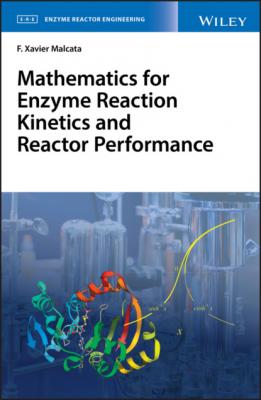Mathematics for Enzyme Reaction Kinetics and Reactor Performance. F. Xavier Malcata
Читать онлайн.| Название | Mathematics for Enzyme Reaction Kinetics and Reactor Performance |
|---|---|
| Автор произведения | F. Xavier Malcata |
| Жанр | Химия |
| Серия | |
| Издательство | Химия |
| Год выпуска | 0 |
| isbn | 9781119490333 |
when solved for the reciprocal of 2R. Insertion of Eq. (2.466) transforms Eq. (2.461) to
(2.467)
– so Eq. (2.456) will be retrieved in full, after reciprocals are taken of all four sides.
Once in possession of Eq. (2.442), one may produce an alias through division of both sides by sin2 x, viz.
(2.468)
which is equivalent to
in view of Eqs. (2.304) and (2.314); if division of both sides is performed by cos2 x instead, then Eq. (2.442) becomes
(2.470)
– which may appear as
at the expense of Eqs. (2.299) and (2.309). Both Eqs. (2.469) and (2.471) may be useful, namely when changing variables throughout integration of some types of functions.
Figure 2.13 Variation, with their argument x, of major inverse trigonometric functions, viz. (a) inverse sine (sin−1) and cosine (cos−1), and (b) inverse tangent (tan−1) and cotangent (cotan−1).
2.3.4 Inverse Functions
In attempts to solve equations explicitly involving trigonometric functions, one may to advantage resort to their inverse functions; this includes sin−1 x, which develops graphically as outlined in Fig. 2.13a. Only the portion of sin−1 x between −π/2 and π/2 – corresponding to x within interval [−1,1], is normally considered, as indicated in bold in Fig. 2.13 a; otherwise a function would not result, since more than one value would be taken by the dependent variable for any given value of the independent variable. By the same token, one may define the inverse of cosine, cos−1 x – as also plotted in Fig. 2.13 a; in this case, one usually restricts to cos−1 x between 0 and π, which corresponds to x spanning also interval [−1,1]. Note that the curves representing inverse functions may be obtained through rotation of the original curves by π rad around the bisectrix of the odd quadrants – see Fig. 2.13a vis‐à‐vis with Fig. 2.10b.
A similar rationale may be pursued to obtain the inverse tangent and cotangent, i.e. tan−1 x and cotan−1 x; these are plotted in Fig. 2.13b. In both cases, argument x spans the whole real axis – but one usually restricts attention to the portion comprised between −π/2 and π/2 in the case of tan−1 x, and to the portion comprised between 0 and π in the case of cotan−1 x, so as to back up true (i.e. single‐valued) functions.
2.4 Hyperbolic Functions
Exponential functions are quite useful in process engineering problems; solutions to differential equations involving an exponential of a given argument, and simultaneously of its negative are indeed frequently found. Therefore, a set of functions termed hyperbolic functions has been designed to assist in the associated modeling; coincidentally, they satisfy most operational relationships of trigonometric functions, and have accordingly also been termed hyperbolic trigonometric functions.
2.4.1 Definition and Major Features
The two basic hyperbolic functions are the hyperbolic sine, sinh x, defined as
and the hyperbolic cosine, cosh x, abiding to
the plots of Eqs. (2.472) and (2.473) are provided in Fig. 2.14a. Note the even nature of cosh x, i.e.
with the aid of Eq. (2.473); in contrast to the odd nature of sinh x, according to
as per Eq. (2.472). The curves representing these two functions overlap at large x, i.e.
(2.476)
stemming from Eqs. (2.472) and (2.473), as emphasized in Fig.
